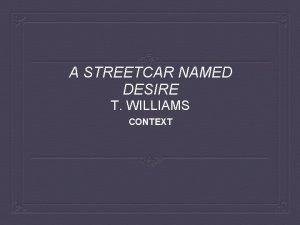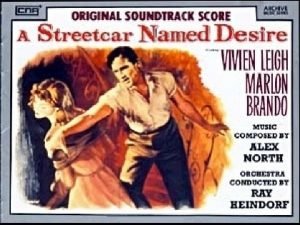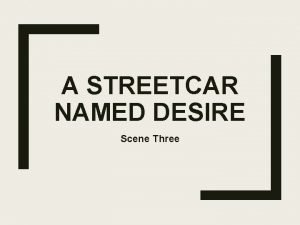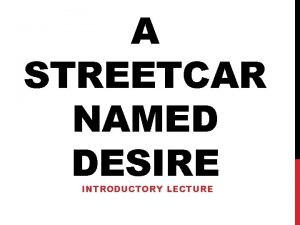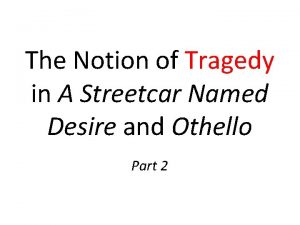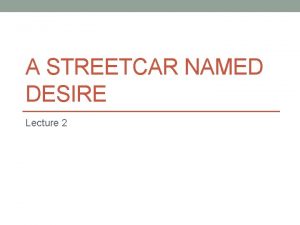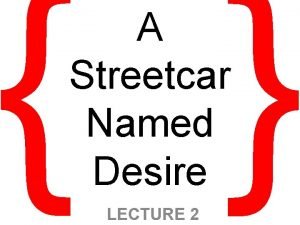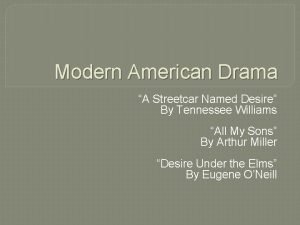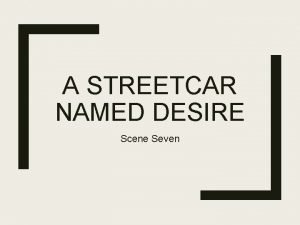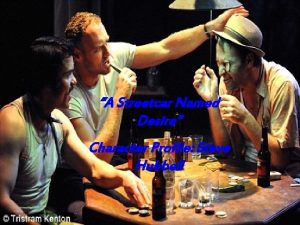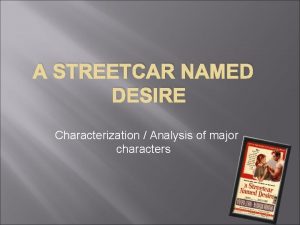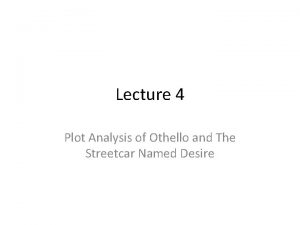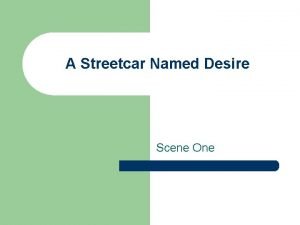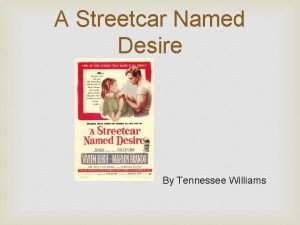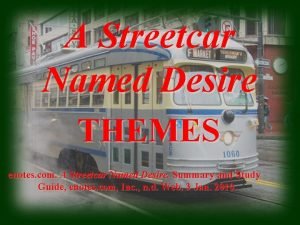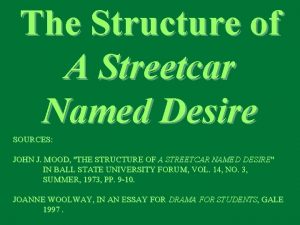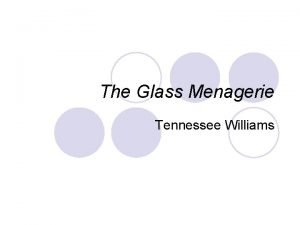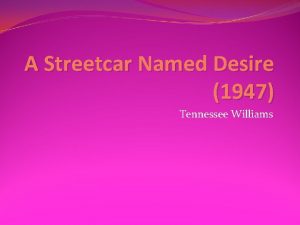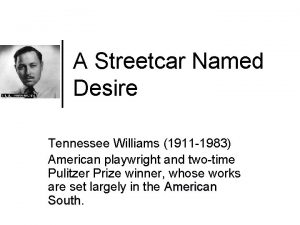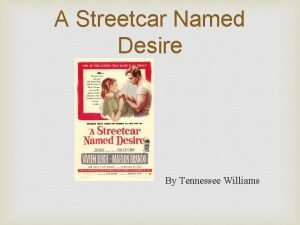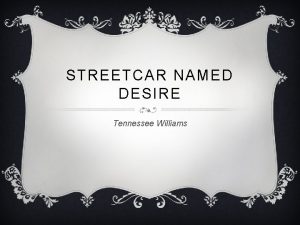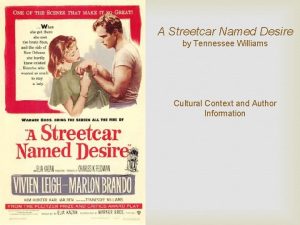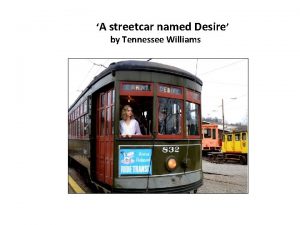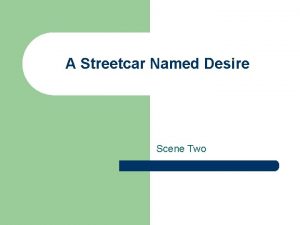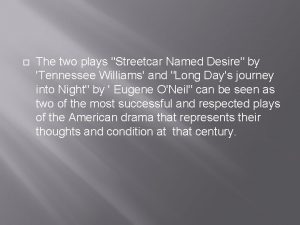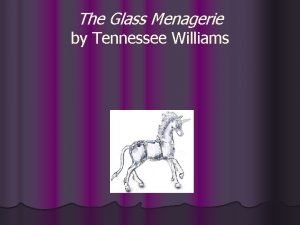Reading Drama Tennessee Williams A Streetcar Named Desire



























- Slides: 27

Reading Drama: Tennessee Williams’ A Streetcar Named Desire David Watson

A play is written to be performed.

Which of the following is the real A Streetcar Named Desire?

A Streetcar Named Desire film poster

A Streetcar Named Marge (1992)

Ingmar Bergman’s A Streetcar Named Desire

Set of A Streetcar Named Desire (opera), composed by André Previn

Cast of Belle Reprieve (1991)

Scene from 1974 production of Streetcar with a black Stanley and white Blanche

Elements of Drama 1) 2) 3) 4) 5) Character Plot and Structure Stage and Setting Tone, language, and symbol Theme

Characterization Since drama frequently does without a narrator, characterization is often indirect. It takes place through stage directions, dialogue, action, setting, and symbols. Example 1: Stanley is a ”gaudy seed-bearer. ” Example 2: “I don’t want realism… I want. Magic!” How would Example 2 have been expressed in prose?

Plot and Structure • Conflict drives a plot. • The typical plot of drama: Exposition; rising action following an inciting incident; climax; falling action and resolution; conclusion. • How does A Streetcar fit this pattern? Does it?

Stage, sets, and setting • Scene 3. The Poker Night There is a picture of Van Gogh’s of a billiard-parlor at night. The kitchen now suggests that sort of lurid nocturnal brilliance, the raw colors of childhood’s spectrum.

Vincent van Gogh’s Night Café

(Polka music sounds, in a minor key faint with distance) We danced the ”Varsouviana!” Suddenly in the middle of the dance the boy I had married broke away from me and ran out of the casino. A few minutes later—a shot! (The polka stops abruptly. BLANCHE rises stiffly…)

Lurid reflections appear on the walls in odd, sinuous shapes. The ”Varsouviana” is filtered into a weird distortion, accompanied by the cries and noises of the jungle. Blanche seizes the back of a chair as if to defend herself.

The music that pervades the play, stage colors, and the phantasmagoria that fills its final scene invite the viewer to experience the play’s performance as embodying the interior worlds of its characters. The dramatic world of the play externalizes the moods and feelings of Blanche, Stanley and the other characters.

READING DRAMA WITHIN ITS CULTURAL AND HISTORICAL CONTEXTS DAVID WATSON

The Original Streetcar Named Desire “They told me to take a streetcar named Desire, and then transfer to one called Cemeteries and ride six blocks and get off at—Elysian fields!”

New Orleans is a cosmopolitan city where there is a relatively warm and easy intermingling of races in the old part of town

Streetcar is set in the American South, and takes as its historical backdrop the demise of the old agrarian South and the growth of a new urban and industrial culture.

Blanche represents an older order—the agrarian South—while Stanley seems to stand for a new urban industrialism. Stanley’s working class, immigrant ambitions for an American identity clashes with Blanche’s sense of history and place.

“The South once had a way of life that I’m just old enough to remember—a culture that had grace, elegance… I write out of regret for that. ”

“Time is short and it doesn’t return again. It is slipping away while I write this and while you read it, and the monosyllable of the clock is Loss, unless you devote your heart to its opposition” ---Tennessee Williams, “On a Streetcar Named Success”

How does Blanche respond to societal changes? “I don’t want realism… I want. Magic!” “I want to create—joie de vivre… we are going to pretend”

One way of making sense of the play’s plot is to view Blanche, as Stanley does, as the feminine other who questions his marriage to Stella, increases his friend Mitch’s “unmanly sensitivity” and theatricalizes and feminizes his home. Needless to say, he responds violently to these pressures.

Femininity is considered abnormal and threatening by Stanley, and his violent outbursts are gendered.
 Streetcar named desire context
Streetcar named desire context A streetcar named desire scene 1
A streetcar named desire scene 1 Van gogh poker night
Van gogh poker night Plastic theatre
Plastic theatre Significance of the title a streetcar named desire
Significance of the title a streetcar named desire Plastic theatre in a streetcar named desire scene 3
Plastic theatre in a streetcar named desire scene 3 A streetcar named desire introduction
A streetcar named desire introduction Is streetcar named desire a tragedy
Is streetcar named desire a tragedy A streetcar named desire themes
A streetcar named desire themes A streetcar named desire setting
A streetcar named desire setting Expressionist theatre streetcar named desire
Expressionist theatre streetcar named desire La dame aux camelias a streetcar named desire
La dame aux camelias a streetcar named desire A streetcar named desire scene 7
A streetcar named desire scene 7 A plastic theatre poem
A plastic theatre poem Belle reve symbolism
Belle reve symbolism A streetcar named desire characters
A streetcar named desire characters What does mitch represent in a streetcar named desire
What does mitch represent in a streetcar named desire A streetcar named desire plot diagram
A streetcar named desire plot diagram A streetcar named desire scene 2 worksheet answers
A streetcar named desire scene 2 worksheet answers Blue piano streetcar
Blue piano streetcar Paper lantern symbolism in a streetcar named desire
Paper lantern symbolism in a streetcar named desire Scene 10
Scene 10 A streetcar named desire vocabulary
A streetcar named desire vocabulary A streetcar named desire themes
A streetcar named desire themes Structure of streetcar named desire
Structure of streetcar named desire Old south vs new south streetcar named desire
Old south vs new south streetcar named desire The glass menagerie themes
The glass menagerie themes Amanda wingfield
Amanda wingfield
